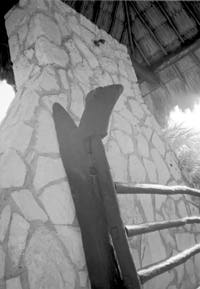
A gate hinge made from a forked log. At a seaside camp for handicapped children called DIF.
ADVENTURES AND ORDEALS WITH A FOLDING PROA ON
THE YUCATAN COAST
Part 2. Paa Mul. Ruins.
Click on any photo to see a higher resolution (~100k) version. Copyright 2001 Tim Anderson
We drove south on highway 307 in our rented car with the canoe tied on top. We were looking for a place to camp and a place to sail to. An hour or so south of Cancun the population thinned out and there were long stretches of coast with no buildings.

A gate hinge made from a forked log. At a seaside
camp for handicapped children called DIF.
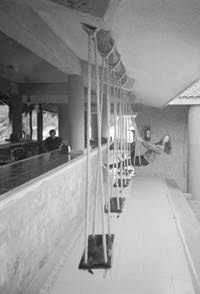
Paa mul is a pretty little rocky bay. It's next
to a big sea turtle sanctuary. It's mostly an RV campground. Most of the
RV's have Mayan thatched roofs called palapas built over them. The restaurant
had swings by the bar. We camped in the back yard of a palapa.
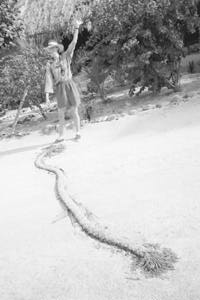
They use mooring hawsers as speed bumps.
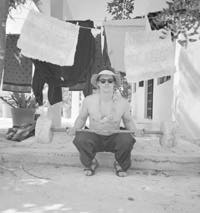
We did our laundry and played with a pair of homemade
weights. Cast concrete on the ends of a pipe. My shirts are in the wash.
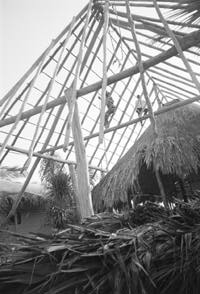
An RV-sized palapa costs $3000 or $4000 us. The
art is surviving well. For us$500 extra, the thatch is grass rather than
palapa palm (palmetto) fronds. Yucatan didn't officially join the Mexican
Federation until 1973. The history is long and interesting. It's covered
at some length in your Lonely Planet guidebook.
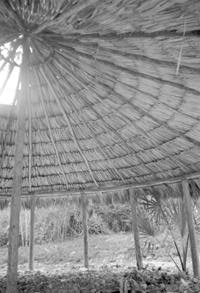
A traditional round palapa with a center pole.
In a hurricane most of the palapas at Paa Mul were knocked down. The ones
that survived had steep roofs and center poles. Some people like to leave
out the center pole because it's an obstruction.
We gathered sticks from the surrounding jungle to lash a better deck. I
split a large bamboo that had drifted ashore. Nina and some locals thought
the bamboo smelled bad. The canoe got a name. "Stinky". The locals
were friendly. They looked forward to seeing us sail. We filled the hull
up with airmattresses for more flotation.
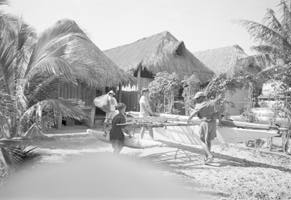
Portaging Stinky to the beach.
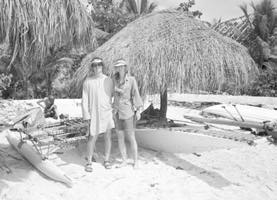
Getting ready to launch. Our wellwishers are out
of the frame. A nice Canadian woman brought a plate of fruit. We paddled
out through mild surf and around the corner. The swells were maybe six feet.
There was plenty of wind, maybe 15 knots from the east with gusts. I had
a hard time raising the sail from the pitching deck. Then it was very hard
to control the canoe. Too much weather helm. I was steering with a paddle
against the lee quarter. This worked before, but not now. The canoe sank
lower in the water. Either the cold water made the air in the bags contract
or something was leaking. With the sail up and pulling well we went crashing
away through the waves. Nina was high in the air on the outrigger as it
got lifted above the water. I was steering with all my strength. The waves
were coming from all directions pushing the boat this way and that. It was
all I could do to keep the canoe from turning into the wind, backwinding
the sail and dropping it on Nina. All I could do wasn't enough. Again and
again the sail crashed down on us. We tried paddling, but we made no headway.
We were in a powerfull current heading north, about 3 knots according to
the chart. The famous Gulf Stream. We'd be back in Cancun in a day at this
rate. Phooey. We watched a palm tree on shore. Every time I got the sail
up and pulling we barely made it back to this palm tree before some mishap,
and then we drifted right back. Current this fast in an ocean was a new
concept to me. I thought they were slow. But this one was faster than the
Mississippi at my hometown in Minnesota. Few people ever try to go upstream
there. It's just too much work. The hull was down in the water. Waves came
up through the deck. When we were sailing there was so much spray and crashing
water that my nylon wind pants got pushed up exposing my bare legs to the
sun. I pushed them down and they got blasted right back up again. A motorboat
came out to ask if we needed a rescue. Of course we said no. It turns out
they hadn't wanted to go out because the water was too rough, but one of
our friends talked them into it. We were getting tired and frustrated. We
weren't going anywhere and it wasn't clear what would have to change to
make the boat work. It was turning into an ordeal. If we kept it up we'd
be landing on rocks and sleeping in wet clothes less than a mile the wrong
direction from our starting place. And have no hope of anything better the
next day. Scott and a friend came paddling out in Scott and Marielis' Folbot.
We admired the way they bobbed lightly over the waves and went wherever
they wanted with apparent ease. I made a couple more attempts to sail. With
the sail up we were faster than the folbot, but it was a huge effort and
I couldn't keep it pointed the right way. Then the sail fell and the Folbot
caught up. They offered to help us back to land. We thought that sounded
pretty good. I guess it's okay to accept help from friends in another folding
canoe.
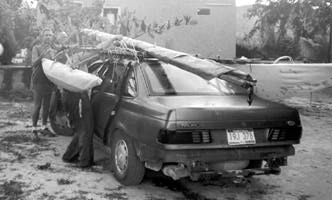
Kenny Coleman gave us a ride back from the turtle
sanctuary to the Palapa-opolis. Scott is at the end of the outrigger.
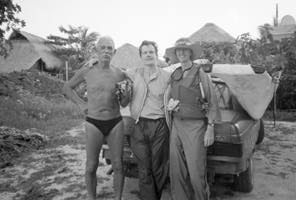
My legs are badly sunburned and would blister
the next day. Kenny said "you're camping with no tent? no blanket?
I think I understand. You're like two little animals."
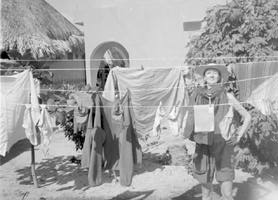
Drying everything out again. We're getting used
to this.
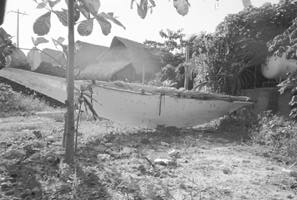
Stinky on land again with Kenny's cat. That night
we slept in Kenny's palapa. Ahh luxury.
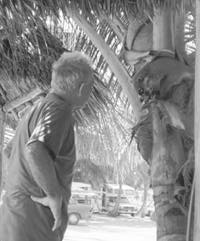
The next day Kenny gave us a ride with our gear
30 km south to a place called Bahias de Punta Soliman. It's 11 km north
of Tulum. There's a restaurant with a tiny campground there. That's Kenny
with one of the mascots, a casimira or coatimundi. Like a skinny raccoon
with a long nose. Kenny's a cheap date cuz he doesn't eat much. His friends
say he's a "Breath-of-air-ian" cuz he lives on a breath of air.
He's reading a book about how eating is unnecessary.
It was time to take a break from boat disasters.
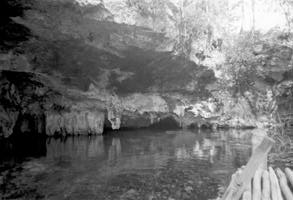
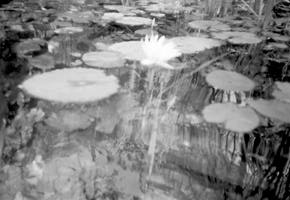
We went swimming in Grand Cenote. There are no
rivers in the Yucatan, only underground rivers. Some have been explored
for many kilometers. Where the underground rivers cave in, there's a Cenote.
There are thousands of these. The lack of rivers is one reason the ocean
water is so clear. I opened the camera up to "make sure the gasket
has no dirt on it before closing the camera" as the instructions had
said. OOPS! I forgot I had a roll of film with pictures in it already. So
some of the photos on this roll were fogged or spoiled, including the underwater
ones. I like this camera a lot. It's a waterproof Canon Sure Shot. us$190
at Long's drugs. Much cheaper than the two cameras per year I've wrecked
by dropping in the water.
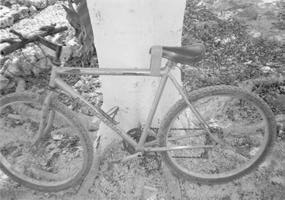
We've all had this problem. Here's a novel solution.
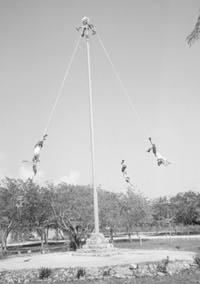
A Mayan spectacle at the Tulum ruins. There's
a wheel and axle at the top of this apparatus. They had the wheel but only
used it for toys. Sort of like the Chinese using gunpowder for toys rather
than weapons.
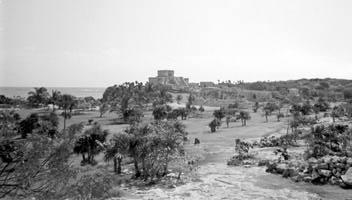
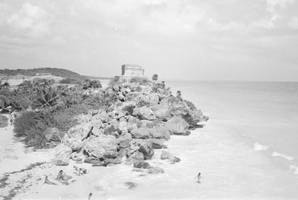
The Tulum ruins. Imagine the colors. The water
is turquose and the beach is white. The sky is blue and the leaves are green.
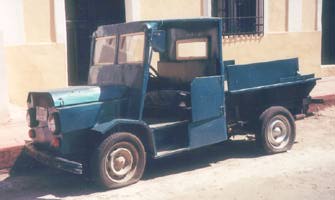
A home made jeep in Valladolid.
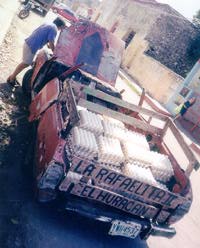
First prize in our "vehicles with character" search. Most
cars in Mexico are now boring and prosperous.
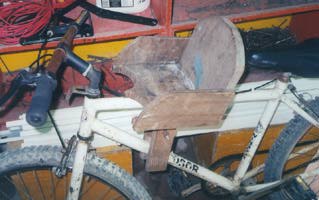
A baby carrier. Furniture stores sell these.
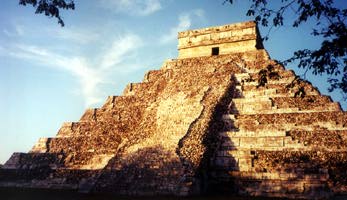
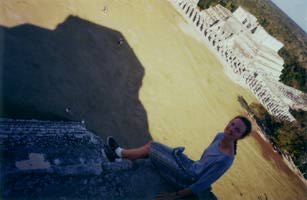
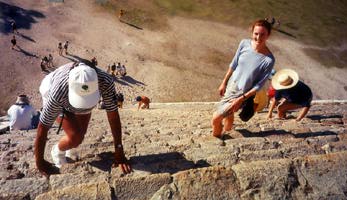
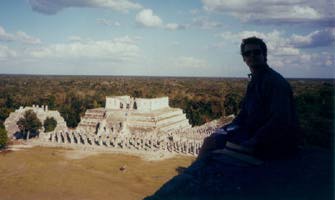
Chichen Itza. The stairs are steep and scary. The view is amazing. A
very impressive place.
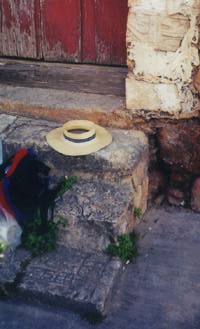
Stones from mayan ruins used to build the local church in the town of
Piste.
End of Part 2.
Copyright 2001 Tim Anderson